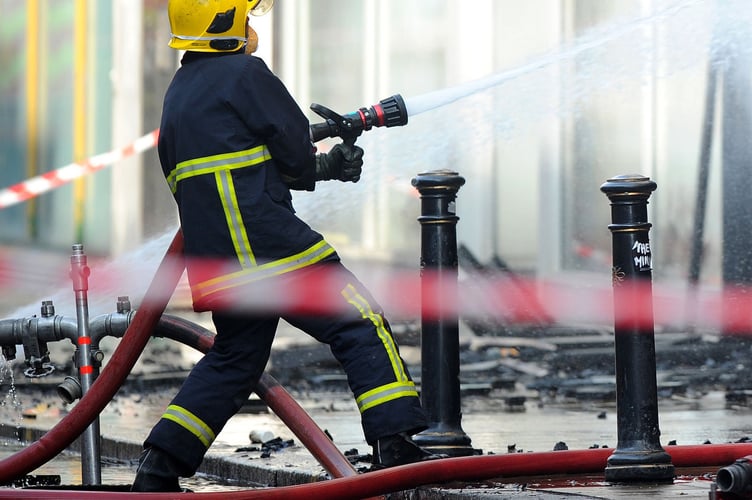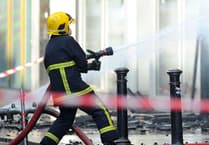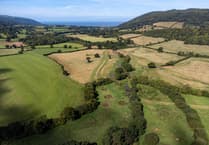Firefighters attended significantly more fires in Avon last year, new figures show.
Meanwhile the number of fires attended by services across England rose by over a quarter, driven by sharp increases in outdoor primary fires and secondary fires.
The Fire Brigades Union warned services across the country "are under more pressure than ever", especially due to increasing numbers of wildfires caused by climate change, and called on the Government for "serious investment".
Statistics released by the Ministry of Housing, Communities and Local Government show the Avon Fire and Rescue Service attended 3,133 fires in the year to June, up 11% from 2,810 the previous year.
Meanwhile fire and rescue services across England attended 165,697 fires in the 12 months to June, marking a 28% jump on the year before.
The significant year-on-year increase was mainly driven by a 52% rise in outdoor primary fires and a 48% rise in secondary fires.
Primary fires are those taking place in buildings, vehicles or outdoors, involving a fatality or casualty, or where five or more crews were called. Secondary fires usually refer to small outdoor fires, not involving people or property.
Overall fire and rescue services attended 6,157 outdoor primary fires and 98,687 secondary fires last year.
The data also shows the number of fire-related fatalities nationally has fluctuated between 200 and 350 per year since 2015, with an exception in 2017 when the Grenfell Tower tragedy took place.
There were 279 fire-related fatalities across England in the year to June, which was up 21% on 231 the previous year. It included three fatalities in Avon.
Steve Wright, FBU general secretary, said: "Fire and rescue services are under more pressure than ever, responding to more incidents with fewer resources.
"Austerity has left fire services across the UK stretched dangerously thin, without the resilience to cope with increasing risks."
He added firefighters are being deployed to increasing numbers of wildfires, driven by rising temperatures caused by climate change.
"Instead of providing the investment urgently needed, the Government inflicted deeper cuts this year," he said.
"Cuts cost lives. Fewer firefighters mean that it takes longer for crews to arrive at emergencies, when every second counts.
"The Labour Government must provide serious investment to rebuild the fire and rescue service and equip firefighters to face these increasing risks."
Overall, fire and rescue services across England attended 628,764 incidents in the 12 months to June, which marked a 6% increase on the previous year and a 25% increase compared with 10 years ago.
This included 12,755 in Avon – up 11% from 11,477 the year before.
Dr Thomas Smith, associate professor in environmental geography at the London School of Economics and Political Science, said: "The climate of the UK has changed in recent decades.
"The length of dry spells and the length, frequency, and severity of heatwaves have all increased in both spring and summer.
"This, in turn, increases the probability of extreme fire weather conditions that favour both the sustained ignition and the spread of fires."
He added the abandonment of "more traditional methods" to keep vegetation loads down, such as grazing and muirburn, the deliberate burning of moorland vegetation, are resulting in "an increasing abundance of flammable vegetation in many places".
He said: "Both the changing climate and land management factors have contributed to this year's record number of fires and burnt area statistics.
"It presents a unique challenge for overly stretched fire and rescue services.
"Fires spreading faster under more extreme conditions lead to exponentially larger fires that are more difficult to tackle with on-the-ground offensive tactics.
"Instead, fire crews are turning to aerial attack and more defensive measures like fighting fire with fire and introducing fuel breaks ahead of a fire front."
Prof David Simon, professor of developmental geography from at Royal Holloway, University of London, said the increasing number of fires due to climate change pose threats to biodiversity, properties and human lives.
He added: "This is a complex issue requiring a multi-faceted strategy, involving a system of well-maintained firebreaks in vulnerable areas; far greater public awareness campaigns that include prominent warning signage around camping and picnic areas, country and national parks; ranger patrols and increased fire-fighting capacity, and during periods of heightened risk also public media announcements."
An MHCLG spokesperson said: "Throughout the country, our firefighters operate in challenging and high-risk environments, constantly going above and beyond the call of duty to protect our communities.
"We will continue to work closely with the sector to ensure all services have the resources they need to protect communities at the highest standard."




